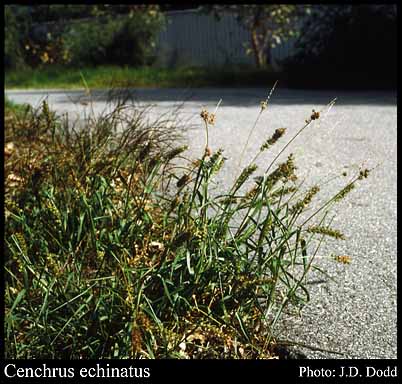- Reference
- Sp.Pl. [Linnaeus] 2:1050 (1753)
- Conservation Code
- Not threatened
- Naturalised Status
- Alien to Western Australia
- Name Status
- Current
Sometimes rhizomatous, tufted annual or perennial (rarely), grass-like or herb, 0.1-0.6(-1.2) m high. Fl. green, Jan to Aug. Sand, red loam, black peaty clay.

Distribution
- IBRA Regions
- Avon Wheatbelt, Carnarvon, Central Ranges, Dampierland, Darwin Coastal, Esperance Plains, Geraldton Sandplains, Gibson Desert, Great Sandy Desert, Indian Tropical Islands, Northern Kimberley, Ord Victoria Plain, Pilbara, Swan Coastal Plain, Victoria Bonaparte.
- IBRA Subregions
- Chichester, Fitzgerald, Fitzroy Trough, Geraldton Hills, Hamersley, Katanning, Keep, Lateritic Plain, Lesueur Sandplain, Mackay, Mann-Musgrave Block, Merredin, Mitchell, Perth, Pindanland, Purnululu, Roebourne, South Kimberley Interzone, Wooramel.
- Local Government Areas (LGAs)
- Ashburton, Belmont, Broome, Carnamah, Cocos Islands, Coorow, Derby-West Kimberley, East Pilbara, Gingin, Greater Geraldton, Irwin, Joondalup, Karratha, Kellerberrin, Melville, Nedlands, Ngaanyatjarraku, Northam, Northampton, Nungarin, Perth, Ravensthorpe, Rockingham, Shark Bay, Wagin, Wyndham-East Kimberley.
Management Notes (for the Swan NRM Region)
Alternative Names. Burrgrass, walkaway burr.
General Biology. Growth form. Grass. Life form. Annual, caespitose. Reproduction. Seed. Dispersal. Wind, mammals, water, clothing. Photosynthetic Pathway. C4. Seedbank persistence. Medium, 1-5 years. Fire response. Stimulates germination of soil-stored seed.
Notes. Common in disturbed sites, particularly on coastal dunes and limestone soils. Also found on cultivated and abandoned fields, pastures, roadsides, lawns, dunes and along river sands. Under dry conditions plants are short-lived, small, and produce few burrs, while under moist conditions they may be long-lived, large and produces many burrs. Rapidly colonises bare or open ground. Withstands repeated defoliation in lawns, harvesting in forage crops or in pastures. Burrs readily attach to clothing or animals and can be carried by water.
Additional information. Origin. South America, southern North America. Similar exotic species. Cenchrus ciliaris.
Suggested method of management and control. Prevent seed set. Manually remove small infestations and isolatated plants. Spray with Verdict 520® 5 ml/10 L (250 ml/ha) + wetting agent or spot spray with 1% glyphosate. Follow-up with seedling control. Read the manufacturers' labels and material safety data sheets before using herbicides. For further information consult the Australian Pesticides and Veterinary Medicines Authority to determine the status of permits for your situation or state.
Management Calendar
| Calendar Type | Jan | Feb | Mar | Apr | May | Jun | Jul | Aug | Sep | Oct | Nov | Dec | Comments |
|---|---|---|---|---|---|---|---|---|---|---|---|---|---|
| Dormant | Y | Y | Y | O | |||||||||
| Active Growth | Y | Y | Y | Y | Y | O | Y | ||||||
| Germination | |||||||||||||
| Flowering | |||||||||||||
| Fruiting | |||||||||||||
| Optimum Treatment |
Legend: Y = Yes, regularly, O = Occasionally, U = Uncertain, referred by others but not confirmed.
References
- Brown, K. & Brooks, K. (2002) Bushland Weeds: A Practical Guide to their Management. Environmental Weeds Action Network, Greenwood.
- Department of Natural Resources and Mines, Queensland (2001) NRM facts pest series. URL: http://www.nrw.qld.gov.au/pests/index.html - Accessed December 2007.
- Flint, E. & Rehkemper, C. (2002) Eradication of Cenchrus echinatus at Layson Island. In Turning the tide: eradication of invasive species. IUCN SSC Invasive Species Specialist Group, Switzerland and Cambridge, UK. Veitch, C.R. & Clout, M.N. (eds), Pages 110-115.
- Forbes, A.E. (2005) Spines and Natural history of three Cenchrus species. American Midland Naturalist, 153 (1): 80-86.
- Hussey, B.M.J., Keighery, G.J., Dodd, J., Lloyd, S.G. & Cousens, R.D. (2007) Western Weeds. A guide to the weeds of Western Australia. 2nd Edition. The Plant Protection Society of Western Australia, Victoria Park.
- Moore, C.B. & Moore, J.H. (2002) Herbiguide, the pesticide expert on a disk. Herbiguide, PO Box 44 Albany, Western Australia, 6330.
- Pacific Island Ecosystems at Risk (2008) Plant threats to Pacific ecosystems. URL: http://www.hear.org/pier/scinames.htm - Accessed January 2010.
- Parsons, W.T. & Cuthbertson, E.G. (2001) Noxious weeds of Australia. 2nd Edition. CSIRO Publishing, Collingwood.